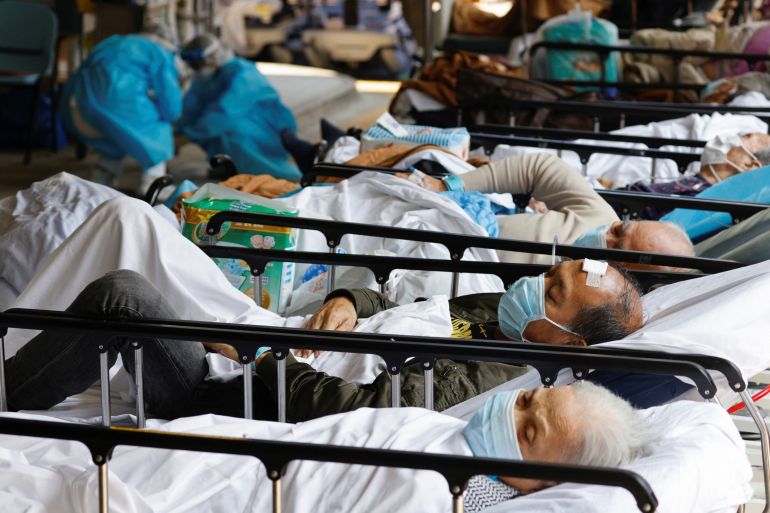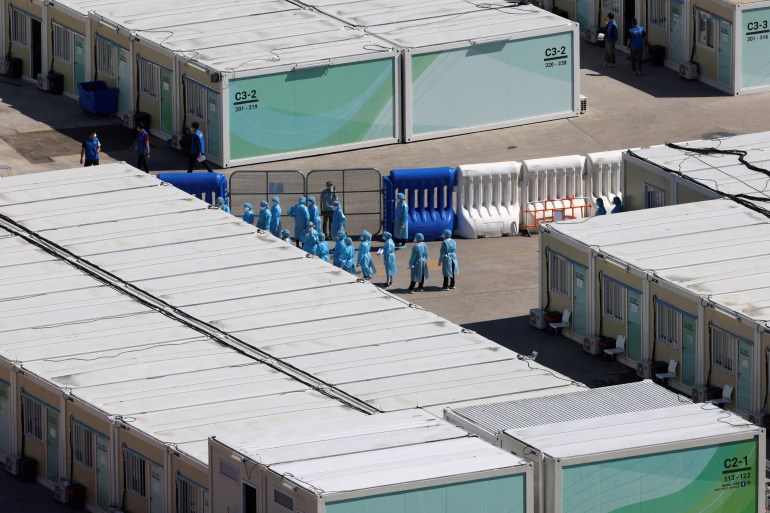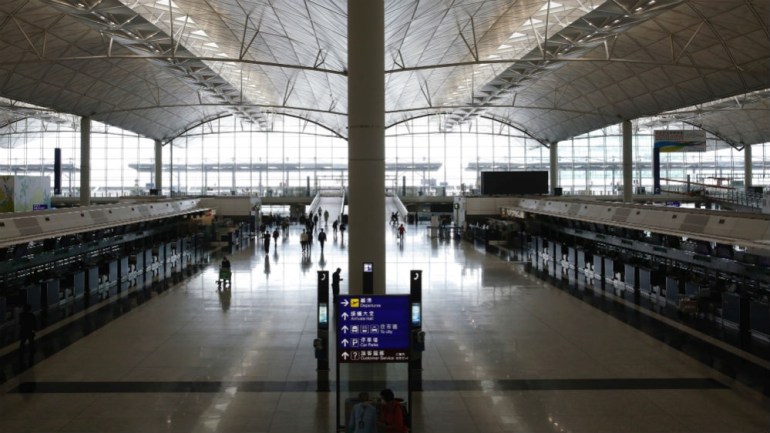In ‘zero COVID’ Hong Kong, deaths smash global records
Poor vaccine coverage among elderly population results in city reporting the highest death rate in the world.

Hong Kong, China – The Hong Kong nursing home where Amy’s 78-year-old mother lives battened down the hatches when the COVID-19 pandemic hit.
Elderly residents were confined within the walls of their rooms. Families were not allowed to visit.
Keep reading
list of 4 itemsFire at Bangladesh Rohingya camp kills boy, leaves 2,000 homeless
In Thailand, businesses feel economic shock of Ukraine war
US rejects Poland’s offer to send MiG-29 fighter jets to Ukraine
As the Chinese territory battled its biggest outbreak of coronavirus cases, staff at the private facility camped out in the office for weeks to avoid bringing the virus with them from outside.
Even so, the inevitable happened. In February, Amy’s mother was among the residents sent to a public hospital’s emergency ward after developing a fever.
“This elderly home has some of the strictest standards in the industry,” Amy, who asked to only be referred to by her first name, told Al Jazeera. “If 80 percent of its residents can be infected, then no other nursing home in Hong Kong can remain unscathed.”
As Hong Kong reports tens of thousands of coronavirus cases each day, the city’s large population of unvaccinated elderly residents has resulted in the highest official death rate per capita of any jurisdiction during the pandemic. Only about 30 per cent of Hong Kong residents over 80 have been double vaccinated despite vaccines being freely available for more than a year, amid widespread vaccine hesitancy among the elderly.

Of 2,365 COVID-19 deaths in the city’s fifth wave so far, 87 percent were aged 60 or above and about 90 percent were not fully vaccinated. Many of the deaths have occurred in the city’s aged care facilities, 87 percent of which have reported infections, involving 16,200 residents and 4,470 staff members.
Though Hong Kong kept COVID-19 at bay throughout much of the pandemic, the highly transmissible Omicron variant eventually broke through the city’s defences, which have included some of the world’s toughest border restrictions.
The resulting surge in infections has overwhelmed the public healthcare system, stretching the capacity of isolation wards, intensive care facilities and mortuaries to their limit. Patients are routinely turned away from hospitals, while high-risk elderly admissions have been left waiting outside, sometimes in the cold.
For Amy, it would be two days before she was informed her mother had been admitted to an observation ward, by which time she was suffering from hypothermia.
Although her condition deteriorated, she was transferred to a temporary hospital on the outlying island of Lantau, which is intended for patients that no longer need a high level of care.
There, it became impossible for Amy to track her mother’s condition, except through occasional phone calls from doctors, who delivered one piece of bad news after another. A phone she sent never reached her mother’s hands. In desperation, Amy attached notes to the nappies in her deliveries to remind her mother she is not alone.
“There are many seniors like her, who need help with every meal and changing their diapers. Caretaking requires a whole network of support. You cannot solve the problem just by building isolation facilities,” Amy said.
Isolation at home
For those quarantining at home in one of the world’s most cramped cities, the situation has been little better. For Ho, a single mother of two and the primary caretaker of her 78-year-old mother, isolating in her 300-square-foot flat proved impossible. Within days of Ho testing positive, all but one of her family members fell ill.
Although Ho’s elderly mother is double-vaccinated, she suffers from chronic kidney and heart conditions, so she dared not self-medicate as many patients are now advised to do.
Ho’s mother made dozens of calls, but was unable to secure a spot at a designated clinic or even book a remote consultation. Ultimately, all she was able to receive was a text message from the Department of Health later in the week, urging her to stay home.
“I had nowhere to turn,” Ho, who requested to be referred to by her first name, told Al Jazeera. “The information from the government is so chaotic, it’s one thing today and another thing tomorrow. No one knows what they should do.”
Officials have flip-flopped on pandemic policies such as a citywide lockdown and universal mass testing, adding to public confusion and prompting panic buying across the city.
For many residents of care homes, the government’s drive to vaccinate the elderly has been too little, too late. An outbound vaccination programme arrived at Amy’s mother’s care home only a week before the outbreak. Even after her assessment, her first shot was scheduled to be administered in several weeks. Speaking on Wednesday, Hong Kong Chief Executive Carrie Lam said her administration is hoping to provide at least one dose of vaccine to all residents at care homes by next Friday.
Recent moves to push up the vaccination rate should have come last year, said Siddharth Sridhar, a clinical virologist at the University of Hong Kong.
“You have to give the immune system some time to respond to the vaccine,” Sridhar told Al Jazeera. “Elderly are now in a race against the virus. Many of them are unfortunately contracting COVID before they are able to form any response, which ideally takes at least two doses against a divergent variant like Omicron.”
Sridhar said authorities should focus on identifying and treating infections early before they progress to cases of severe disease. Such an approach would require logistical changes, such as sending healthcare professionals to care homes instead of having patients come to hospitals.

Critics have highlighted Hong Kong’s insistence on sticking with an elimination strategy to align with Beijing as a misstep that fuelled complacency and poor preparation in the run-up to the inevitable outbreak.
The stringent approach, which includes travel bans, mandatory quarantine and business closures, has prompted an exodus of talent from the city as residents and companies tire of two years of restrictions with no end in sight.
“When we started seeing an exponential rise, it would have been wise to focus as much as possible on mitigation to reduce the impact on the healthcare system,” said Sridhar, pointing to authorities’ continuing efforts to isolate mild cases.
“When you have tens of thousands of cases every day, and the healthcare system is clearly struggling, then you really have to focus on what is achievable, rather than attempting to isolate every case,” he said.
The current wave is set to peak within a week, meaning cases may soon begin to drop, according to modelling. But the death rate, which typically lags infections, is likely to remain high for some time longer.
For Amy and her mother, the ordeal is far from over.
Although her mother is still battling pulmonary oedema and severe pneumonia brought on by the coronavirus, Amy has been told her care home will not accept returning patients.
“These are definitely the most difficult days of her life,” Amy said.